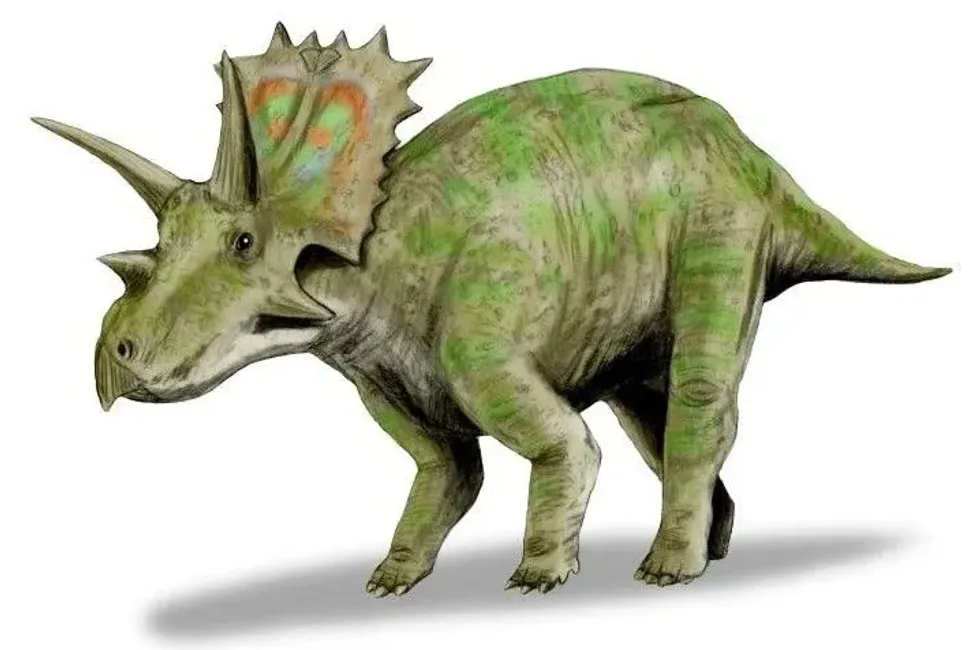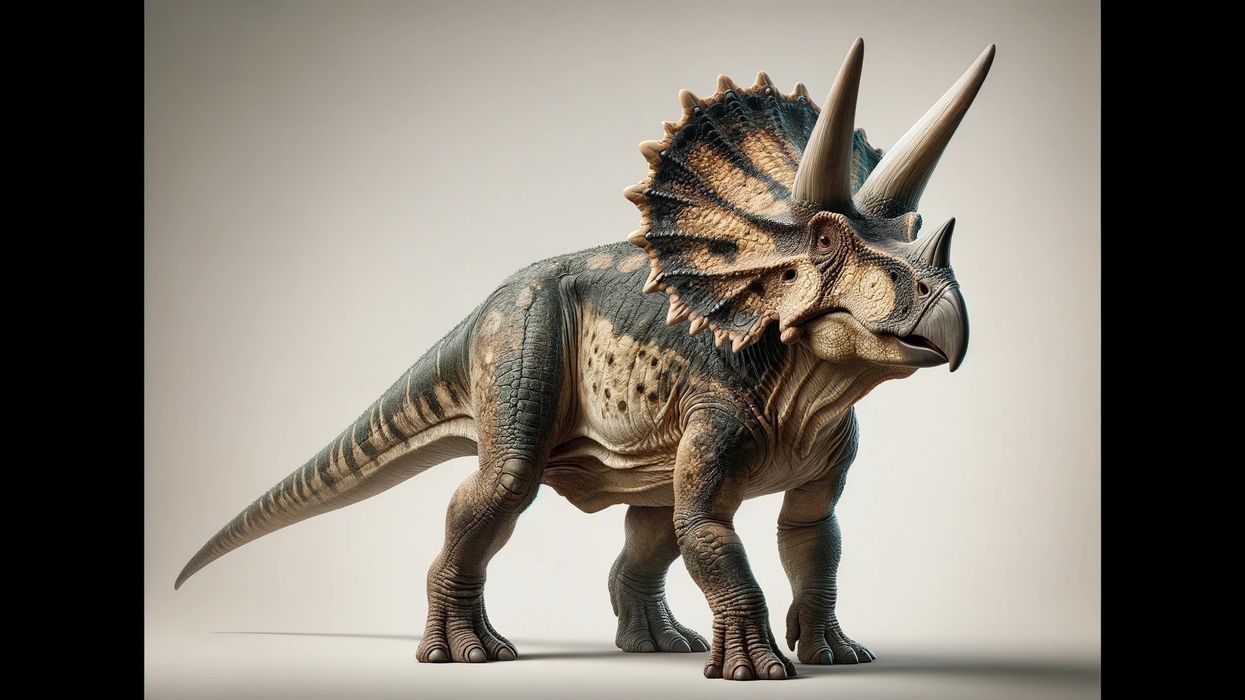The Anchiceratops was a plant-eating dinosaur that came from the same class as reptiles and belonged to the Ceratopsidae. These dinosaurs, at first glance, resemble the rhinoceros with their two long horns on the browbone and a short one on the nose.
These four-legged dinosaurs were believed to have gone extinct about 70-74 million years ago in the Cretaceous period and their fossil remains were excavated in the Horseshoe Canyon Formation, a fossil site in Alberta.
Fragmentary fossil skull bones have also been found in the St. Mary River Formation deposits dated to the same age as the Horseshoe Canyon Formation by Wann Langston.
The original Anchiceratops specimen was discovered by Barnum Brown of the American Museum of National History in 1912 and consisted of only the back part of the skull, but since that time several specimens have been found, including a nearly complete skeleton now at the National Museum of Canada.
Scientists and paleontologists have stated that the reason behind their extinction could have been the shrinking of the Western interior seaway, which would have wiped out its population.
Today, just one genuine species (A. ornatus) is recognized, which gets its name from the frill. A. longirostris was the name given to a second species by Charles M. Sternberg in 1929.
A. Longirostris means 'long snout'. In 1925, Sternberg found a headless skeleton that he thought belonged to Anchiceratops.
However, he stated that it could belong to a new genus.
Other skulls have been found but they have never been described. Studies of fossil sites where Anchiceratops remains have been found have revealed that these horned dinosaurs lived around river deltas, floodplains, shorelines, and estuaries.
Anchiceratops' body was very much like other ceratopsians except that it had a very short tail.
The most distinctive feature of the Anchiceratop dinosaurs was their frills. It was a unique neck frill that was moderately long and rectangular with small oval openings.
The snout on some specimens was suspected to be quite long and the long face would have helped them with breathing in the swampy, marshy regions.
This ceratopsian dinosaur had a bony skull. Anchiceratops are known mainly from skull material, although the spine and possibly other skeletal material have been identified as well.
If you'd like to discover more fun facts on similar dinosaur species, check out our Xenoceratops interesting facts for kids or Bravoceratops fun facts for kids.
Anchiceratops Interesting Facts
How do you pronounce 'Anchiceratops'?
Anchiceratops, which is mainly known from the skull material alone, is pronounced as 'ang-kee-serr-a-tops'.
What type of dinosaur was an Anchiceratops?
The Anchicerotop was a ceratopsian herbivorous dinosaur whose fossils were discovered in 1912 by Barnum Brown in the Horseshoe Canyon Formation, an excavation site in Alberta.
In which geological period did the Anchiceratops roam the Earth?
These ceratopsids species lived approximately 72 to 71 million years ago during the latter part of the Cretaceous Period in what is now Alberta, Canada. It had a big head with a long, rectangular frill at the back and three horns on its face, two above its eyes and one nasal horn.
When did the Anchiceratops become extinct?
These ceratopsian horned dinosaurs became extinct around 71 million years ago.
Where did an Anchiceratops live?
The Anchiceratops ornatus, which had a short nasal horn, lived in swamps, marshy regions, wetlands, riverbanks, shorelines, and estuaries. The range of these ceratopsids was common in Alberta, Canada where the first specimen was found by Barnum Brown in 1912.
What was an Anchiceratops' habitat?
This herbivorous dinosaur species, whose fossils were found in the Horseshoe Canyon Formation preferred living in terrestrial habitats. They made their homes in or near wet places like marshy places, wetlands, swamps, and so on, grazing by themselves.
Who did an Anchiceratops live with?
Scientists believed that Anchiceratops lived in large groups, where they grazed and moved together from one habitat to the other.
How long did an Anchiceratops live?
It is not known for how long this ceratopsian herbivore has as their range became extinct a long time ago.
How did they reproduce?
Since dinosaurs shared the same characteristics and mannerisms as birds and certain reptiles, they also shared similar breeding patterns. Birds and reptiles have a cloaca – a single opening used for excretion, urination, mating, and laying eggs so it has always been assumed that dinosaurs had them too. The cloaca of the psittacosaurus confirms this expectation.
Anchiceratops Fun Facts
What did an Anchiceratops look like?

Scientists were able to draw out results from the limited parts of the Anchiceratops skeleton that they found. Like a large number of other ceratopsians, the Anchiceratops skull is the only part of its body found so it was a little hard to make out what their whole body looks like.
Being about 4000 lb (1814.3 kg) in weight, their skulls were extremely large with three horns on them.
It is suspected that these ceratopsids had long snouts.
Anchiceratops fossils were discovered in the low-lying sediments of marshy environments, which made many scientists conclude that it was probably an inhabitant of swampy regions.
In 1959, Langston stated that the long face might have helped the animal to breathe easily in these marshy environments or while it was in shallow waters but this theory was refuted by many scientists.
How many bones did an Anchiceratops have?
To date, only the skulls of these dinosaurs have been found so it is difficult to state how many bones they had. So far, only the skulls of six specimens have been found.
How did they communicate?
These horned dinosaurs probably communicated both vocally and visually. Defensive posturing, courtship behaviors, and territorial fights probably involved both vocal and visual displays. Since these ceratopsids had horns on their faces and were big in size, they would have engaged with each other a little aggressively.
How big was an Anchiceratops?
Anchiceratops were massive animals and quite huge in size but they lacked in height. This dinosaur was 20 ft (6 m) in length. The Anchiceratops size was three times bigger than the present-day rhinoceros!
How fast could an Anchiceratops move?
The Anchiceratops ornatus species, largely herbivores, are believed to be quite fast although the exact speed at which they moved quickly is unknown.
How much did an Anchiceratops weigh?
The Anchiceratops' weight was about 4000 lb (1814.3 kg), the same as an African elephant!
What were the male and female names of the species?
There were no specific male or female names of these species whose fossils were discovered in the horseshoe canyon formation. They are called by their common name which is Anchiceratops or Anchiceratops ornatus.
What would you call a baby Anchiceratops?
The babies of these dinosaurs, with a long frill on the back of its head, hatched from eggs. Just like their reptile cousins the turtles and crocodiles, the baby of this three-horned dinosaur species is called a hatchling or nestling.
What did they eat?
Although they came from the same class as reptiles, these dinosaur species with big skulls were largely herbivores, feeding on vegetation and plants in large groups. They shared the same diet patterns with deers, sheep, antelopes, cows, and bison.
How aggressive were they?
They would have displayed a certain degree of aggression but there isn't enough evidence available to depict how aggressive they were. The large skull, sharp big frill, three big horns were all part of their anatomy and they would have used to defend themselves in times of danger or threat.
Did you know...
Males seemed to have shorter snouts than the females and combined with their long horns, it probably made it easier for males to fight each other in order to show dominance by slamming their horns into one another. In 1990, Leham decided that the A. Longirostris was nothing but the female of the A. ornatus species.
Scientists Dodson and Curie conducted their own study and agreed to this as well but Sternberg stated that they probably belonged to a new genus.
Anchiceratops vs. Triceratops
Said to have belonged to a new genus by C.M. Sternberg, the Anchiceratops is a lesser-known member of the dinosaur family which includes triceratops. With the long snout and structure of the skull, they look similar to each other but Anchiceratops are smaller in size than the triceratops and their horns are also suspected to be shorter.










